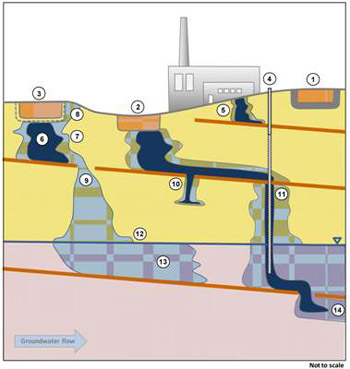Dissolved phase plumes in the unsaturated zone
The development of dissolved phase volatile organic compound (VOC) plumes in the unsaturated zone may result from a number of source zone scenarios, including disposal lagoons, landfills (lined or unlined) and point source releases (Figure 1).
Elevated dissolved phase VOC concentrations may result from direct discharge of waste waters or from dissolution of non-aqueous phase liquids (NAPL).
Small to medium releases of NAPL that fail to generate sufficient capillary pressure to substantially invade the unsaturated zone to depth, or where the vertical migration is limited by the presence of low permeability barriers, may remain as shallow sources that may be subsequently leached (dissolved) by infiltrating water.
Where infiltration occurs, either directly through the unsaturated zone or through the waste materials in disposal facilities, a dissolved-phase VOC plume will evolve that may impact a significant thickness of unsaturated zone.
Shallow leachable VOC sources are a relatively common phenomenon that may pose a substantial long-term environmental liability.
Research aims
The key drivers for understanding the impacts of shallow leachable NAPL source zones, or aqueous-discharge sources, on the unsaturated zone are the need to:
- reduce uncertainty in prediction of timeframes for migration through the unsaturated zone that may range from hours to decades
- quantify the significance of the various natural attenuation processes that may retard or remove dissolved phase VOCs and delay, or even prevent, arrival at the water table
- facilitate development of appropriate risk assessment methodologies and remediation strategies
The status of current knowledge and capability concerning unsaturated zone transport and attenuation of VOC plumes has been critically reviewed by Wealthall et al., 2010.
Selected publications
Wealthall et al. 2010. A review of transport and attenuation of dissolved-phase volatile organic compounds (VOCs) in the unsaturated zone. British Geological Survey Commissioned Report,OR/10/06. 101pp.
Contact
Contact Dan Lapworth







